2015 FIAT GRANDE PUNTO ACTUAL steering
[x] Cancel search: steeringPage 167 of 216
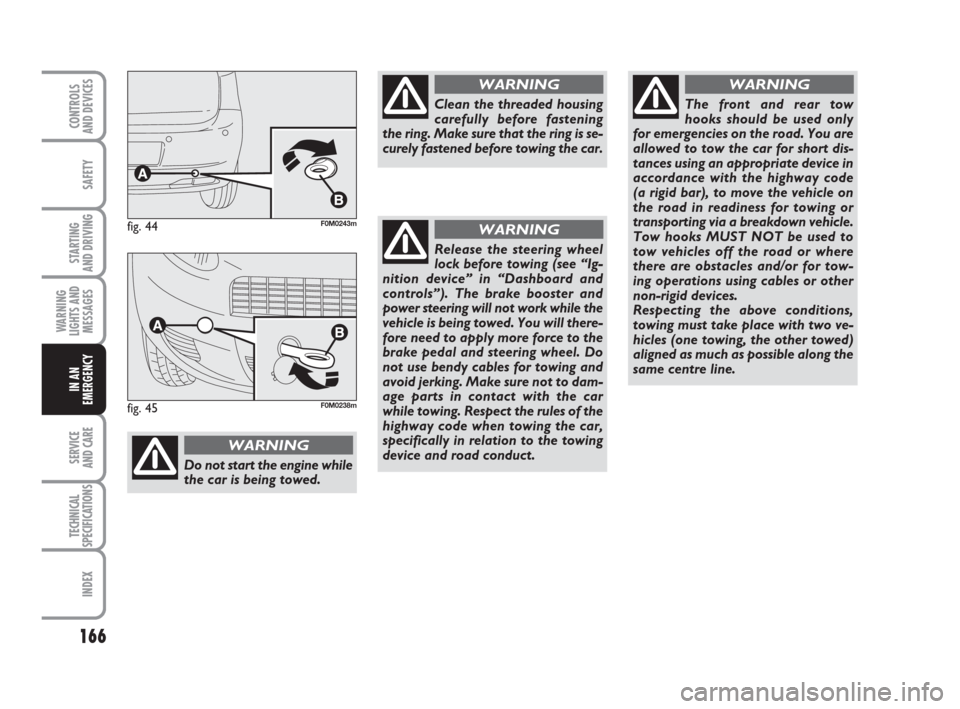
166
SAFETY
STARTING
AND DRIVING
WARNING
LIGHTS AND
MESSAGES
SERVICE
AND CARE
TECHNICAL
SPECIFICATIONS
INDEX
CONTROLS
AND DEVICES
IN AN
EMERGENCY
Do not start the engine while
the car is being towed.
WARNING
Clean the threaded housing
carefully before fastening
the ring. Make sure that the ring is se-
curely fastened before towing the car.
WARNING
Release the steering wheel
lock before towing (see “Ig-
nition device” in “Dashboard and
controls”). The brake booster and
power steering will not work while the
vehicle is being towed. You will there-
fore need to apply more force to the
brake pedal and steering wheel. Do
not use bendy cables for towing and
avoid jerking. Make sure not to dam-
age parts in contact with the car
while towing. Respect the rules of the
highway code when towing the car,
specifically in relation to the towing
device and road conduct.
WARNING
The front and rear tow
hooks should be used only
for emergencies on the road. You are
allowed to tow the car for short dis-
tances using an appropriate device in
accordance with the highway code
(a rigid bar), to move the vehicle on
the road in readiness for towing or
transporting via a breakdown vehicle.
Tow hooks MUST NOT be used to
tow vehicles off the road or where
there are obstacles and/or for tow-
ing operations using cables or other
non-rigid devices.
Respecting the above conditions,
towing must take place with two ve-
hicles (one towing, the other towed)
aligned as much as possible along the
same centre line.
WARNING
fig. 44F0M0243m
fig. 45F0M0238m
135-166 ACTUAL 1ed EN 26-07-2010 16:00 Pagina 166
Page 182 of 216
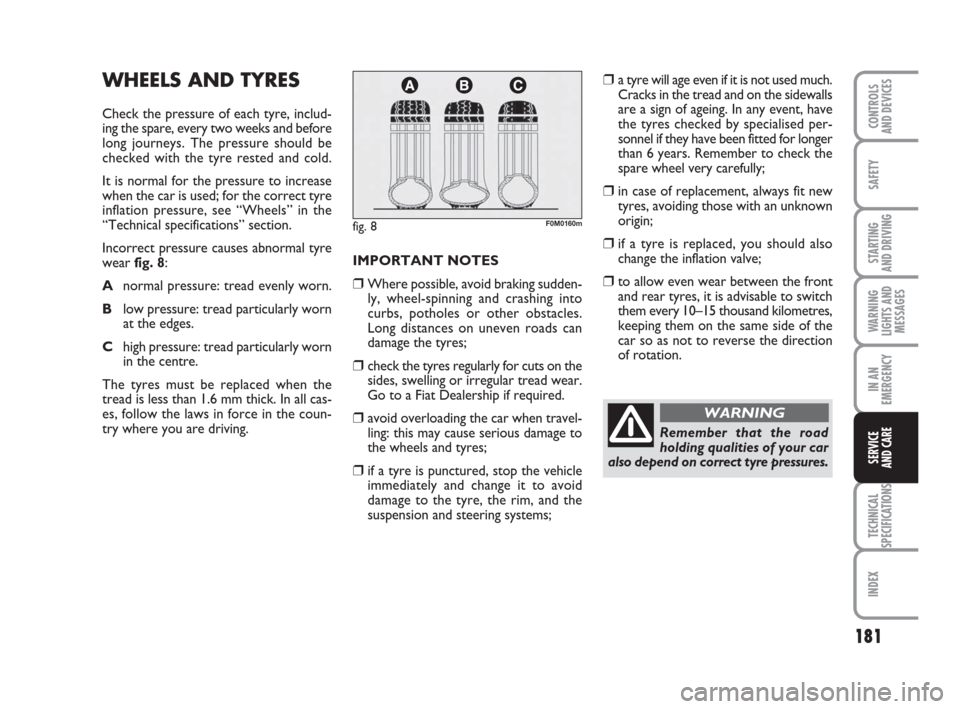
181
SAFETY
STARTING
AND DRIVING
WARNING
LIGHTS AND
MESSAGES
IN AN
EMERGENCY
TECHNICAL
SPECIFICATIONS
INDEX
CONTROLS
AND DEVICES
SERVICE
AND CARE
WHEELS AND TYRES
Check the pressure of each tyre, includ-
ing the spare, every two weeks and before
long journeys. The pressure should be
checked with the tyre rested and cold.
It is normal for the pressure to increase
when the car is used; for the correct tyre
inflation pressure, see “Wheels” in the
“Technical specifications” section.
Incorrect pressure causes abnormal tyre
wearfig. 8:
Anormal pressure: tread evenly worn.
Blow pressure: tread particularly worn
at the edges.
Chigh pressure: tread particularly worn
in the centre.
The tyres must be replaced when the
tread is less than 1.6 mm thick. In all cas-
es, follow the laws in force in the coun-
try where you are driving.
fig. 8F0M0160m
IMPORTANT NOTES
❒Where possible, avoid braking sudden-
ly, wheel-spinning and crashing into
curbs, potholes or other obstacles.
Long distances on uneven roads can
damage the tyres;
❒check the tyres regularly for cuts on the
sides, swelling or irregular tread wear.
Go to a Fiat Dealership if required.
❒avoid overloading the car when travel-
ling: this may cause serious damage to
the wheels and tyres;
❒if a tyre is punctured, stop the vehicle
immediately and change it to avoid
damage to the tyre, the rim, and the
suspension and steering systems;
❒a tyre will age even if it is not used much.
Cracks in the tread and on the sidewalls
are a sign of ageing. In any event, have
the tyres checked by specialised per-
sonnel if they have been fitted for longer
than 6 years. Remember to check the
spare wheel very carefully;
❒in case of replacement, always fit new
tyres, avoiding those with an unknown
origin;
❒if a tyre is replaced, you should also
change the inflation valve;
❒to allow even wear between the front
and rear tyres, it is advisable to switch
them every 10–15 thousand kilometres,
keeping them on the same side of the
car so as not to reverse the direction
of rotation.
Remember that the road
holding qualities of your car
also depend on correct tyre pressures.
WARNING
167-186 ACTUAL 1ed EN 27-07-2010 10:30 Pagina 181
Page 187 of 216

186
SAFETY
STARTING
AND DRIVING
WARNING
LIGHTS AND
MESSAGES
IN AN
EMERGENCY
TECHNICAL
SPECIFICATIONS
INDEX
CONTROLS
AND DEVICES
SERVICE
AND CARE
The fabric upholstery of your
car is designed to withstand
normal wear and tear for
a long time. Some precautions
are however needed. Avoid prolonged
rubbing against clothing accessories,
such as metal buckles, bosses, Velcro
strips and the like, which by applying
a high pressure on the fabric in a small
area could cause the breakage of some
threads and damage the upholstery. SEATS AND FABRIC PARTS
Remove dust with a soft brush or a vacu-
um cleaner. It is advisable to use a damp
brush on velvet upholstery.
Wipe the seats with a sponge soaked in
a solution of mild detergent and water.
Never use flammable prod-
ucts, such as petroleum
ether or modified petrol, to clean the
inside the car. The electrostatic
charges which are generated by rub-
bing during cleaning may cause a fire.
WARNING
Do not keep aerosol cans in
the vehicle: these could ex-
plode. Aerosol cans must not be ex-
posed to temperatures exceeding
50 °C. When the vehicle is exposed to
sunlight, the temperature inside can
greatly exceed this value.
WARNING
INTERIOR
Check regularly that water is not trapped
under the mats (due to drops from shoes,
umbrellas, etc.), as this could cause the
sheet metal to rust.IMPORTANT Never use alcohol- or
petrol-based products to clean the in-
strument panel.
GENUINE LEATHER STEERING
WHEEL/GEAR LEVER KNOB
These components must be cleaned with
mild soap and water only.
Never use spirits and/or alcohol-based
products.
Before using off-the-shelf products de-
signed for cleaning vehicle interiors, make
sure that they do not contain spirits and/
or alcohol-based substances.
If window cleaner accidentally drips onto
the steering wheel or gear lever knob,
wipe away immediately and then wash the
affected area with mild soap and water.
IMPORTANT When arranging a steering
wheel locking device, be careful not to dam-
age the leather upholstery.
PLASTIC PARTS
It is advisable to clean interior plastic parts
with a damp cloth and a solution of water
and mild, non-abrasive detergent. To re-
move grease and tough stains, use products
designed specifically for cleaning plastics.
These have no solvents and have been de-
signed so that they do not alter the ap-
pearance and colour of the components.
167-186 ACTUAL 1ed EN 27-07-2010 10:30 Pagina 186
Page 188 of 216

187
SAFETY
STARTING
AND DRIVING
WARNING
LIGHTS AND
MESSAGES
IN AN
EMERGENCY
SERVICE
AND CARE
INDEX
CONTROLS
AND DEVICES
TECHNICAL
SPECIFICATIONS
IDENTIFICATION DATA ................................................. 188
ENGINE CODES – BODYWORK VERSIONS ............. 184
ENGINE .................................................................................. 191
FUEL SUPPLY ........................................................................ 192
TRANSMISSION .................................................................. 192
BRAKES .................................................................................. 193
SUSPENSIONS ...................................................................... 193
STEERING SYSTEM ............................................................. 193
WHEELS ................................................................................. 194
PERFORMANCES ................................................................ 197
DIMENSIONS ....................................................................... 198
WEIGHTS .............................................................................. 199
CAPACITIES .......................................................................... 201
FLUIDS AND LUBRICANTS ............................................. 202
FUEL CONSUMPTION ...................................................... 204
CO
2EMISSIONS .................................................................. 204
T T
E E
C C
H H
N N
I I
C C
A A
L L
S S
P P
E E
C C
I I
F F
I I
C C
A A
T T
I I
O O
N N
S S
187-204 ACTUAL 1ed EN 26-07-2010 16:08 Pagina 187
Page 194 of 216
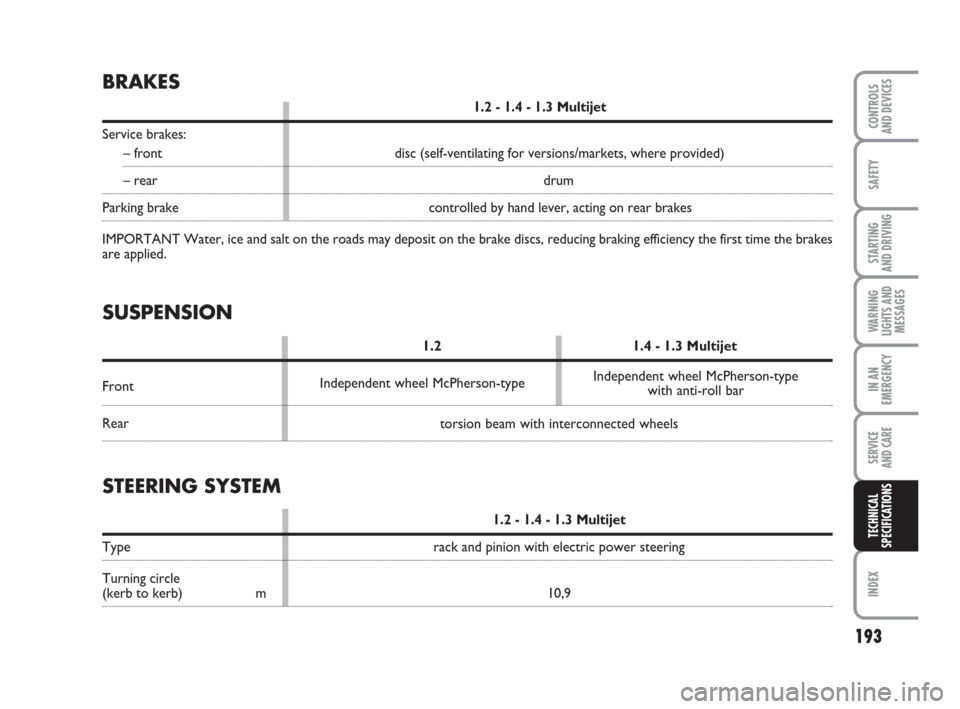
torsion beam with interconnected wheels
193
SAFETY
STARTING
AND DRIVING
WARNING
LIGHTS AND
MESSAGES
IN AN
EMERGENCY
SERVICE
AND CARE
INDEX
CONTROLS
AND DEVICES
TECHNICAL
SPECIFICATIONS
BRAKES
1.2 - 1.4 - 1.3 Multijet
Service brakes:
– front disc (self-ventilating for versions/markets, where provided)
– rear drum
Parking brake controlled by hand lever, acting on rear brakes
IMPORTANT Water, ice and salt on the roads may deposit on the brake discs, reducing braking efficiency the first time the brakes
are applied.
STEERING SYSTEM
1.2 - 1.4 - 1.3 Multijet
Type rack and pinion with electric power steering
Turning circle
(kerb to kerb) m 10,9
Independent wheel McPherson-typeIndependent wheel McPherson-type
with anti-roll bar
SUSPENSION
1.2 1.4 - 1.3 Multijet
Front
Rear
187-204 ACTUAL 1ed EN 26-07-2010 16:08 Pagina 193
Page 208 of 216
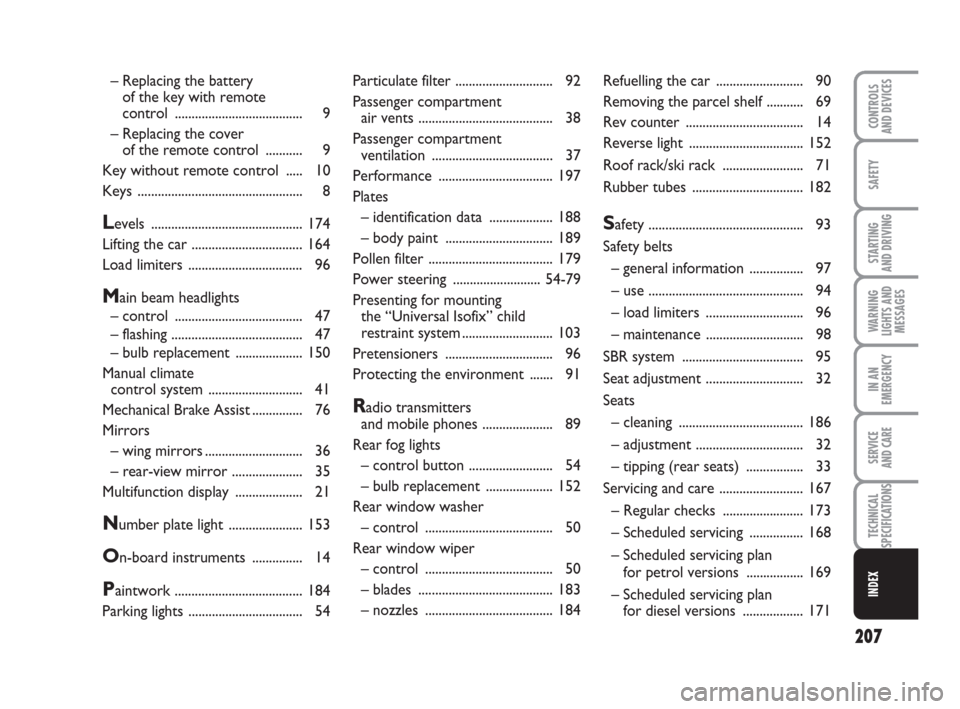
207
SAFETY
STARTING
AND DRIVING
WARNING
LIGHTS AND
MESSAGES
IN AN
EMERGENCY
SERVICE
AND CARE
TECHNICAL
SPECIFICATIONS
INDEX
CONTROLS
AND DEVICES
Particulate filter ............................. 92
Passenger compartment
air vents ........................................ 38
Passenger compartment
ventilation .................................... 37
Performance .................................. 197
Plates
– identification data ................... 188
– body paint ................................ 189
Pollen filter ..................................... 179
Power steering ..........................54-79
Presenting for mounting
the “Universal Isofix” child
restraint system........................... 103
Pretensioners ................................ 96
Protecting the environment ....... 91
Radio transmitters
and mobile phones ..................... 89
Rear fog lights
– control button ......................... 54
– bulb replacement .................... 152
Rear window washer
– control ...................................... 50
Rear window wiper
– control ...................................... 50
– blades ........................................ 183
– nozzles ...................................... 184Refuelling the car .......................... 90
Removing the parcel shelf ........... 69
Rev counter ................................... 14
Reverse light .................................. 152
Roof rack/ski rack ........................ 71
Rubber tubes ................................. 182
Safety .............................................. 93
Safety belts
– general information ................ 97
– use .............................................. 94
– load limiters ............................. 96
– maintenance ............................. 98
SBR system .................................... 95
Seat adjustment ............................. 32
Seats
– cleaning ..................................... 186
– adjustment ................................ 32
– tipping (rear seats) ................. 33
Servicing and care ......................... 167
– Regular checks ........................ 173
– Scheduled servicing ................ 168
– Scheduled servicing plan
for petrol versions ................. 169
– Scheduled servicing plan
for diesel versions .................. 171 – Replacing the battery
of the key with remote
control ...................................... 9
– Replacing the cover
of the remote control ........... 9
Key without remote control ..... 10
Keys ................................................. 8Levels ............................................. 174
Lifting the car ................................. 164
Load limiters .................................. 96
Main beam headlights
– control ...................................... 47
– flashing ....................................... 47
– bulb replacement .................... 150
Manual climate
control system ............................ 41
Mechanical Brake Assist............... 76
Mirrors
– wing mirrors ............................. 36
– rear-view mirror ..................... 35
Multifunction display .................... 21
Number plate light ...................... 153
On-board instruments ............... 14
Paintwork ...................................... 184
Parking lights .................................. 54
205-214 ACTUAL 1ed EN 26-07-2010 16:15 Pagina 207
Page 209 of 216

208
SAFETY
STARTING
AND DRIVING
WARNING
LIGHTS AND
MESSAGES
IN AN
EMERGENCY
SERVICE
AND CARE
TECHNICAL
SPECIFICATIONS
INDEX
CONTROLS
AND DEVICES
Steering ........................................... 193
Steering wheel adjustment ......... 35
Steering wheel lock ...................... 12
Sun visors ....................................... 59
Sunroof ........................................... 60
– emergency operation ............. 61
Suspension ..................................... 193
Symbols ........................................... 6
Technical specifications .............. 187
Third brake light ........................... 153
Tool kit ........................................... 138
Top speeds ..................................... 196
Towing the car .............................. 165
Towing trailers .............................. 118
– installing the tow hook .......... 119
Transmission .................................. 192
Trip computer ............................... 30
Tyre pressures .............................. 196
Tyres
– standard tyres provided ........ 196
– reading tyre markings ............ 194
– maintenance ............................. 181
– pressure .................................... 197
– changing .................................... 137
Tyre Rim Protector....................... 195
Using the manual gearbox ......... 116
Warning lights and messages ... 123
Weights .......................................... 199
Wheel rims
– reading rim markings ............. 195
Wheel trim .................................... 194
Wheels
– trim ............................................ 194
– spare .......................................... 194
– changing .................................... 137
When parked ................................ 115
Window washing .......................... 49
Windows (cleaning) ..................... 185
Windscreen and rear window
wiper blades ................................ 183
Windscreen washer
– control ..................................... 49
– fluid level ................................... 178
Windscreen wipers
– control ..................................... 49
– blades ........................................ 183
– nozzles ...................................... 183
Windscreen/rear window
washer level ................................. 178 – Demanding use of the car .... 173
Side airbags .................................... 107
Side/taillights
– control ...................................... 47
– front bulb replacement .......... 149
– rear bulb replacement ........... 151
Smart washing ............................... 49
Snow chains ................................... 121
Snow tyres ..................................... 196
Socket ............................................. 59
Sound system ................................ 81
Spark plugs
– type ............................................ 191
Speedometer ................................. 14
Starting and driving ....................... 111
Starting the engine
– jump starting ............................ 136
– bump starting ........................... 136
– emergency starting ................. 136
– ignition device ......................... 12
– procedure for petrol
versions ..................................... 112
– procedure for diesel
versions ..................................... 113
– how to warm up the engine
after it has just started .......... 114
– stopping the engine ................ 114
205-214 ACTUAL 1ed EN 26-07-2010 16:15 Pagina 208
Page 213 of 216
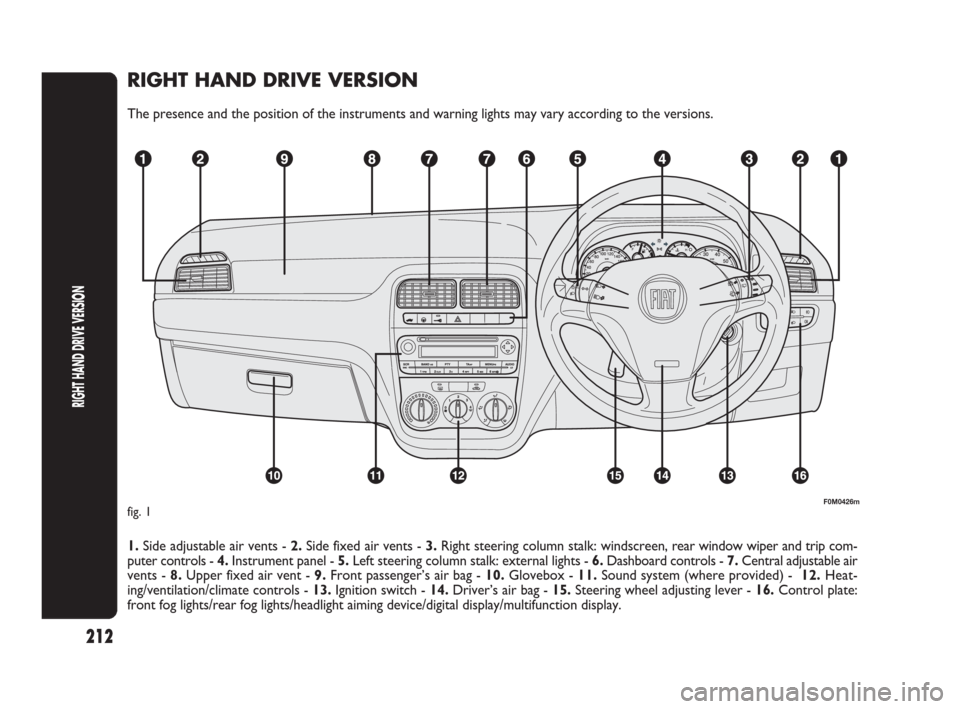
RIGHT HAND DRIVE VERSION
The presence and the position of the instruments and warning lights may vary according to the versions.
1. Side adjustable air vents - 2.Side fixed air vents - 3.Right steering column stalk: windscreen, rear window wiper and trip com-
puter controls - 4.Instrument panel - 5.Left steering column stalk: external lights - 6.Dashboard controls - 7.Central adjustable air
vents - 8.Upper fixed air vent - 9.Front passenger’s air bag - 10.Glovebox - 11.Sound system (where provided) - 12.Heat-
ing/ventilation/climate controls - 13.Ignition switch - 14.Driver’s air bag - 15.Steering wheel adjusting lever - 16.Control plate:
front fog lights/rear fog lights/headlight aiming device/digital display/multifunction display.
F0M0426mfig. 1
212
RIGHT HAND DRIVE VERSION
205-214 ACTUAL 1ed EN 26-07-2010 16:15 Pagina 212